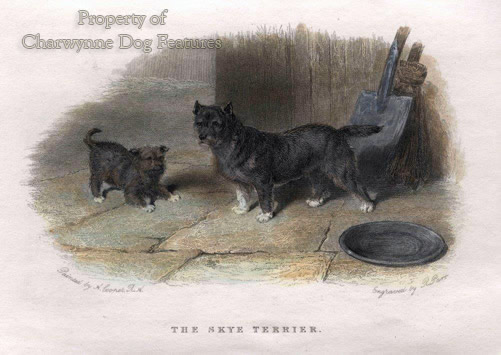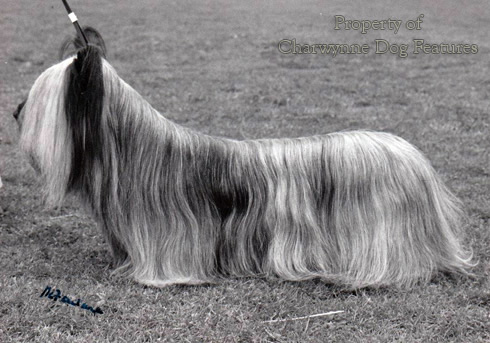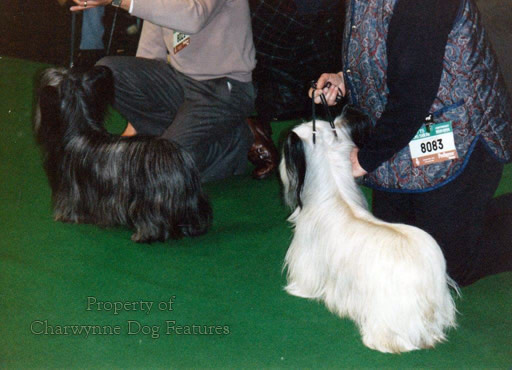814 THE SKYES THE LIMIT
THE SKYE'S THE LIMIT
by David Hancock
 “The shepherds know the holes and caves where the foxes breed, and during the winter and spring these are all systematically visited. Two neighbouring farmers, perhaps, may join forces with the gamekeeper representing the shooting tenant. They will be attended on their visitation by ten or twelve little terriers of all sorts, upon whom the real burden of work falls. These dogs are a very mixed lot, not much to look at maybe, but keen on their work for all that…Dandie-dinmonts there are, of all colours, real Skye terriers, - not the corpulent creatures of the shows, tousy as an unshaven poodle – smooth English terriers, Irish terriers, black Scotch terriers. And a hideous row they unite in raising.”
“The shepherds know the holes and caves where the foxes breed, and during the winter and spring these are all systematically visited. Two neighbouring farmers, perhaps, may join forces with the gamekeeper representing the shooting tenant. They will be attended on their visitation by ten or twelve little terriers of all sorts, upon whom the real burden of work falls. These dogs are a very mixed lot, not much to look at maybe, but keen on their work for all that…Dandie-dinmonts there are, of all colours, real Skye terriers, - not the corpulent creatures of the shows, tousy as an unshaven poodle – smooth English terriers, Irish terriers, black Scotch terriers. And a hideous row they unite in raising.”
 Those words by DL Cameron, in a piece entitled Fox-hunting in the Highlands, and published in The Badminton Magazine of 1901, indicate very clearly an admiration for the working terriers used in Scotland, as well as a certain scorn for show dogs, even at that stage of the exhibiting sporting terriers from Scotland. The Skye Terrier of today's show rings is more a warm-blooded draught-excluder than the sporting terrier its KC Grouping claims. But what would a dog need to work as a terrier in Scotland? Essentially it must possess a strong prey-drive on underground vermin; then immense determination in pursuing its quarry. But without a physical capability to work underground or in rocky crevices: powerful digging feet on strong legs with ample length, a strong jaw, a protective but not handicapping jacket and an eel-like forward movement, especially in confined spaces, it just could not cope. And as far as coat-length is concerned the Skye's is the limit!
Those words by DL Cameron, in a piece entitled Fox-hunting in the Highlands, and published in The Badminton Magazine of 1901, indicate very clearly an admiration for the working terriers used in Scotland, as well as a certain scorn for show dogs, even at that stage of the exhibiting sporting terriers from Scotland. The Skye Terrier of today's show rings is more a warm-blooded draught-excluder than the sporting terrier its KC Grouping claims. But what would a dog need to work as a terrier in Scotland? Essentially it must possess a strong prey-drive on underground vermin; then immense determination in pursuing its quarry. But without a physical capability to work underground or in rocky crevices: powerful digging feet on strong legs with ample length, a strong jaw, a protective but not handicapping jacket and an eel-like forward movement, especially in confined spaces, it just could not cope. And as far as coat-length is concerned the Skye's is the limit!
 Yet, in his 'Dogs of Scotland', published in 1891, Thomson Gray wrote: "The perfection to which the coat of the Skye Terrier has been brought is something wonderful. We have measured hair on the body of a Skye Terrier 12 inches long, and 8 to 10 inches is not uncommon. Only by careful selection, and constant attention to coat, can such length be obtained." I wonder if this 'attention to coat' has always been to the advantage of the Skye Terrier as a dog. Certainly their popularity is not increasing with the years: 110 registered in 1986, 100 in 1990 and 65 in 2000, but down to under 50 in 2012 does not augur well for the breed. If 'attention to coat' translates as a great need for attention to coat-care, then this could put off a potential owner with a busy life and higher priorities than prolonged grooming of a dog. And why should such an ornamental breed still be called a terrier, an earth-dog?
Yet, in his 'Dogs of Scotland', published in 1891, Thomson Gray wrote: "The perfection to which the coat of the Skye Terrier has been brought is something wonderful. We have measured hair on the body of a Skye Terrier 12 inches long, and 8 to 10 inches is not uncommon. Only by careful selection, and constant attention to coat, can such length be obtained." I wonder if this 'attention to coat' has always been to the advantage of the Skye Terrier as a dog. Certainly their popularity is not increasing with the years: 110 registered in 1986, 100 in 1990 and 65 in 2000, but down to under 50 in 2012 does not augur well for the breed. If 'attention to coat' translates as a great need for attention to coat-care, then this could put off a potential owner with a busy life and higher priorities than prolonged grooming of a dog. And why should such an ornamental breed still be called a terrier, an earth-dog?
 Long coats in breeds of dog have created a mini-industry in two senses; firstly there is the provision of special tables, combs, brushes, shampoos, hair dryers, protective clothing and even top-knot ribbons, and, secondly there is the work undertaken by fanciers at home and at shows, whose industriousness never ceases to amaze me. I am all in favour of dogs being well groomed for the show ring, a dirty unkempt dog should never win. But are we getting to the stage where it's all getting out of hand? I don't mean the cost of it all, the time it all takes and the space it demands at crowded show venues, I mean the imposition on the dog both by way of the length and weight of coat and by making the dog stand for long periods being preened. An over-long coat and an over-long back has no value for a sporting breed.
Long coats in breeds of dog have created a mini-industry in two senses; firstly there is the provision of special tables, combs, brushes, shampoos, hair dryers, protective clothing and even top-knot ribbons, and, secondly there is the work undertaken by fanciers at home and at shows, whose industriousness never ceases to amaze me. I am all in favour of dogs being well groomed for the show ring, a dirty unkempt dog should never win. But are we getting to the stage where it's all getting out of hand? I don't mean the cost of it all, the time it all takes and the space it demands at crowded show venues, I mean the imposition on the dog both by way of the length and weight of coat and by making the dog stand for long periods being preened. An over-long coat and an over-long back has no value for a sporting breed.
 Breeds like the Skye and the Dandie are now longer in the back and shorter in the leg than their ancestors. Working hunt terriers are usually a little longer backed than their show ring opposite numbers but for a good reason, the long, sloping shoulder tending to accompany the slightly longer back, with the pursuit of a cobbier terrier, with the shorter back, encouraging the more upright shoulder. Dogs required to work underground need flexible backs so that they can work in confined spaces; the Skye Terrier needs saving from the show ring exaggerators, being recast by some patriotic islander and restored to the terrier ranks as a proper earth-dog - soon!
Breeds like the Skye and the Dandie are now longer in the back and shorter in the leg than their ancestors. Working hunt terriers are usually a little longer backed than their show ring opposite numbers but for a good reason, the long, sloping shoulder tending to accompany the slightly longer back, with the pursuit of a cobbier terrier, with the shorter back, encouraging the more upright shoulder. Dogs required to work underground need flexible backs so that they can work in confined spaces; the Skye Terrier needs saving from the show ring exaggerators, being recast by some patriotic islander and restored to the terrier ranks as a proper earth-dog - soon!
Have the terrier breeds of Scotland lost their sporting heritage? The West Highland is a show ring favourite; the Cairn has a loyal following, with, I understand, at least one working terrier backer; the Skye could be lost to us within half a century. The Scottie is still with us but like the others has no discernible working activity. The Dandie Dinmont has, I believe, a tiny band of working devotees. Do any of them deserve to retain their sporting terrier tag? Working use apart, do these breeds still retain the anatomy to work? I despair when I hear a show breeder of these worthy and long-established breeds declare that he “doesn’t want his terriers to go to ground, so why get 'het-up' about the ability to do so”. So much for respecting the origins of your breed!